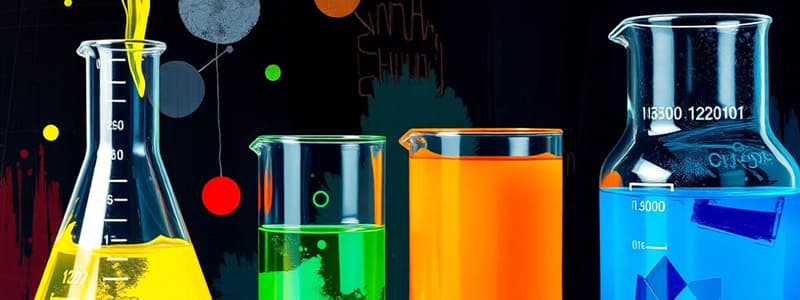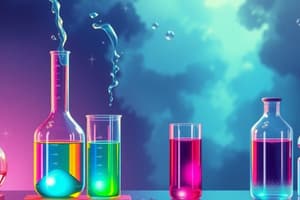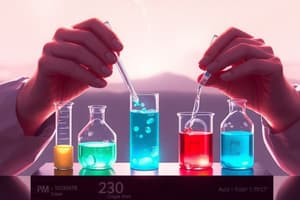Podcast
Questions and Answers
In a neutralization reaction, what are the products when an acid reacts with a base?
In a neutralization reaction, what are the products when an acid reacts with a base?
- A salt and a different base
- Only water
- Only a salt
- A salt and water (correct)
What determines whether the medium resulting from mixing an acid and a base will be acidic, basic, or neutral?
What determines whether the medium resulting from mixing an acid and a base will be acidic, basic, or neutral?
- Only the type of acid used
- Only the type of base used
- The amounts and concentrations of the acid and base mixed (correct)
- The temperature of the solution
Besides an acid and a base, what is essential to use to ensure the precise neutralization of a solution?
Besides an acid and a base, what is essential to use to ensure the precise neutralization of a solution?
- A catalyst
- A thermometer
- A buffer solution
- An indicator (correct)
What laboratory apparatus is recommended for the controlled addition of an acid to a base during a neutralization process?
What laboratory apparatus is recommended for the controlled addition of an acid to a base during a neutralization process?
During the preparation of a neutral solution, you observe that adding a single drop of acid causes the indicator to change color. What does this signify?
During the preparation of a neutral solution, you observe that adding a single drop of acid causes the indicator to change color. What does this signify?
In the context of acid-base neutralization, what is the significance of achieving a pH of 7?
In the context of acid-base neutralization, what is the significance of achieving a pH of 7?
If 25 ml of a 0.1 M acid solution is required to neutralize 25 ml of a base solution, what can you conclude about the base solution?
If 25 ml of a 0.1 M acid solution is required to neutralize 25 ml of a base solution, what can you conclude about the base solution?
A student is performing a neutralization reaction but forgets to add an indicator. What is the most likely outcome?
A student is performing a neutralization reaction but forgets to add an indicator. What is the most likely outcome?
In the described experiment, if the universal indicator in the middle of the test tube shows a green color, what does this indicate about the chemical environment?
In the described experiment, if the universal indicator in the middle of the test tube shows a green color, what does this indicate about the chemical environment?
What would be the likely outcome if the experiment's test tube was shaken vigorously immediately after adding the acid?
What would be the likely outcome if the experiment's test tube was shaken vigorously immediately after adding the acid?
In the experiment, why does the bottom of the test tube initially exhibit a blue color after adding sodium carbonate and universal indicator?
In the experiment, why does the bottom of the test tube initially exhibit a blue color after adding sodium carbonate and universal indicator?
Considering the described reaction between sodium carbonate and acid, what products would you expect to form based on the provided equation: $Na_2CO_3 + 2HCl \rightarrow 2NaCl + CO_2 + H_2O$?
Considering the described reaction between sodium carbonate and acid, what products would you expect to form based on the provided equation: $Na_2CO_3 + 2HCl \rightarrow 2NaCl + CO_2 + H_2O$?
What would happen if a stronger acid, such as concentrated sulfuric acid ($H_2SO_4$), was used in the experiment instead of a weaker acid?
What would happen if a stronger acid, such as concentrated sulfuric acid ($H_2SO_4$), was used in the experiment instead of a weaker acid?
In this experiment, what visual evidence indicates that a neutralization reaction is occurring within the test tube?
In this experiment, what visual evidence indicates that a neutralization reaction is occurring within the test tube?
Based on the experimental setup, where would you expect to find the lowest pH value in the test tube?
Based on the experimental setup, where would you expect to find the lowest pH value in the test tube?
If the experiment were conducted with potassium hydroxide (KOH) instead of sodium carbonate ($Na_2CO_3$), what initial color would you expect to observe at the bottom of the test tube after adding the universal indicator?
If the experiment were conducted with potassium hydroxide (KOH) instead of sodium carbonate ($Na_2CO_3$), what initial color would you expect to observe at the bottom of the test tube after adding the universal indicator?
What modification to the existing experiment would allow you to determine the exact pH at different points in the test tube more accurately?
What modification to the existing experiment would allow you to determine the exact pH at different points in the test tube more accurately?
Using the concept of neutralization, if you have a solution with a pH of 12, which of the following would be MOST effective in bringing the solution closer to a neutral pH of 7?
Using the concept of neutralization, if you have a solution with a pH of 12, which of the following would be MOST effective in bringing the solution closer to a neutral pH of 7?
Flashcards
Neutralization Reaction
Neutralization Reaction
Reaction between an acid and a base, producing salt and water.
Indicator (in Neutralization)
Indicator (in Neutralization)
A substance that changes color to show when a solution is neutralized.
Burette
Burette
Laboratory glassware used to deliver a precise volume of liquid.
Neutralization Process
Neutralization Process
Signup and view all the flashcards
Neutral Medium
Neutral Medium
Signup and view all the flashcards
Acidic Medium
Acidic Medium
Signup and view all the flashcards
Basic Medium
Basic Medium
Signup and view all the flashcards
Indicator color at pH7
Indicator color at pH7
Signup and view all the flashcards
Acid
Acid
Signup and view all the flashcards
Base
Base
Signup and view all the flashcards
Universal Indicator
Universal Indicator
Signup and view all the flashcards
pH Scale
pH Scale
Signup and view all the flashcards
Na₂CO₃
Na₂CO₃
Signup and view all the flashcards
Neutralization
Neutralization
Signup and view all the flashcards
Bottom of the Test Tube (Experiment)
Bottom of the Test Tube (Experiment)
Signup and view all the flashcards
Neck of the Test Tube (Experiment)
Neck of the Test Tube (Experiment)
Signup and view all the flashcards
Middle of the Test Tube (Experiment)
Middle of the Test Tube (Experiment)
Signup and view all the flashcards
Study Notes
Neutralization
- Acids react with bases, producing salt and water, as shown by the reaction: HCl + NaOH -> NaCl + H2O.
- This type of reaction is called a neutralization reaction.
- When mixing an acid with a base, the resulting environment can be acidic, basic, or neutral, depending on the amounts of acid and base mixed, as well as their concentrations.
- If the concentrations of the acid and base are equal, adding more acid leads to an acidic environment, and vice versa, adding more base leads to a basic environment.
- For the environment to be neutral, besides the acid and base, an indicator must be used, which changes color precisely when the solution becomes neutral after the reaction of with the base.
Preparing A Neutral Solution
- To achieve this, use a laboratory device called a burette.
- Fill the burette with 50 ml of 0.1 M acid.
- Place a certain amount of base, for example, 25 ml, in a conical flask.
- Open the burette tap to allow the acid to drip slowly.
- Mix the contents by swirling the conical flask several times.
- Basisc solutions are neutral solutions that have consumed 25 ml of acid, resulting in a pH of 7.
- Adding more drops of acid changes the color due to the environment becoming acidic.
Activity: How is the Rainbow Formed After the Rain?
- Pour some sodium carbonate (Na2CO3) into a test tube.
- Carefully add water up to 2/3 of the test tube's volume.
- Add a few drops of universal indicator in the form of a paper strip and place it from the bottom of the test tube up to its neck.
- Carefully add a bit of acid.
- Do not shake or mix the test tube contents.
- Leave the test tube in the test tube holder for a few days and note the changes.
How the Rainbow is Produced in a Test Tube?
- At the bottom of the test tube, sodium carbonate dissolves in water, and the universal indicator turns blue, making the environment strongly basic.
- After a while, Na2CO3 particles and the indicator spread, mixing with the water particles, making the solution light blue and basic.
- At the neck of the test tube, universal indicator particles meet acid particles, its color turns from blue to red, making the environment strongly acidic.
- In the middle of the test tube, acid particles that spread from top to bottom mix with the sodium carbonate particles spreading from bottom to top.
- This neutralizes each other, turning the universal indicator green.
Summary
- Acids and bases neutralize each other.
- A reaction between an acid and a base is called a neutralization reaction.
- To neutralize a certain amount of base, a certain amount of acid must be used.
- Bases and acids react in equal amounts, based on the ratios of molecules involved in the reaction.
Studying That Suits You
Use AI to generate personalized quizzes and flashcards to suit your learning preferences.




